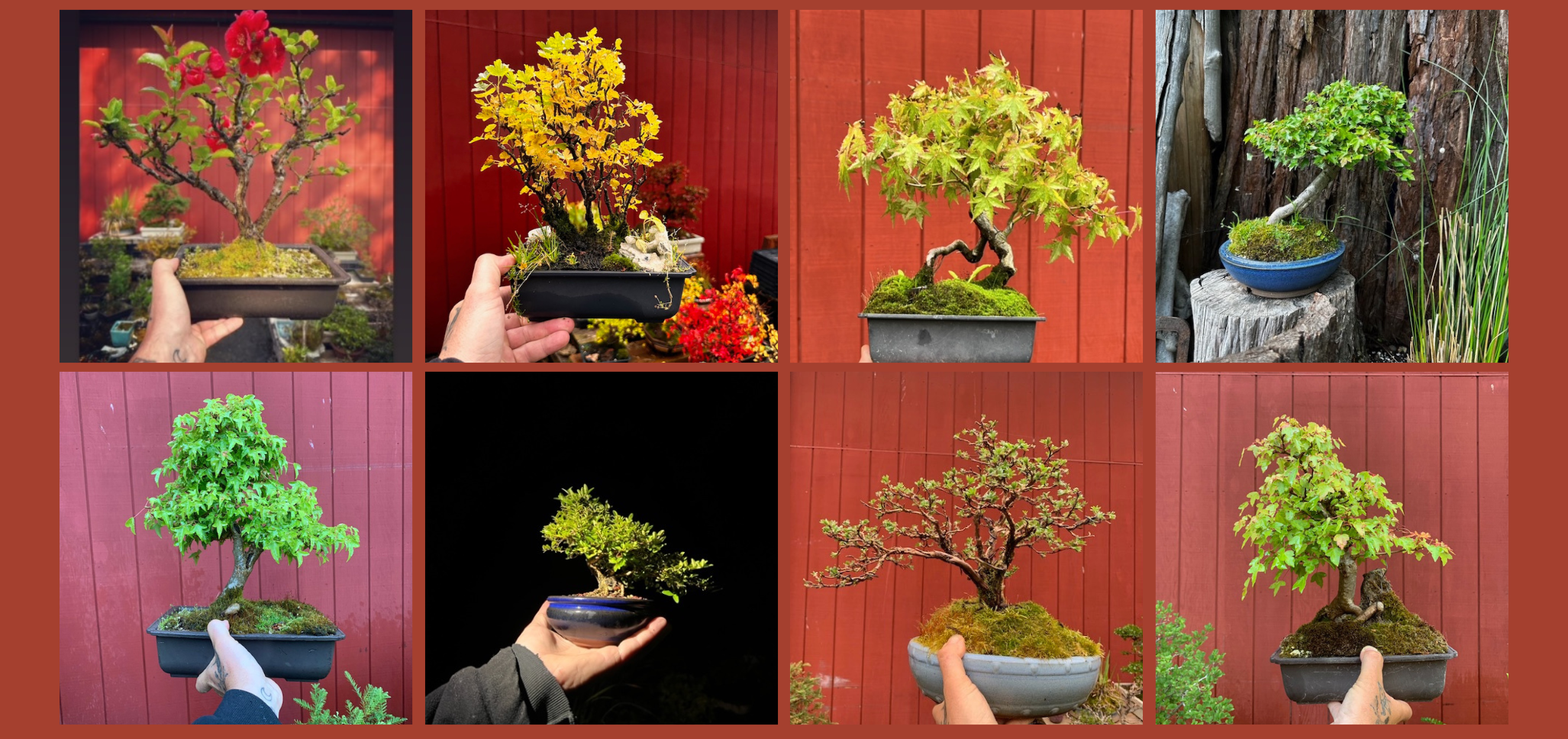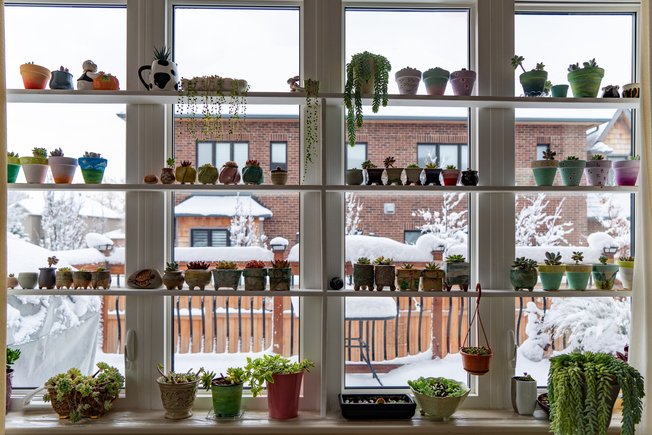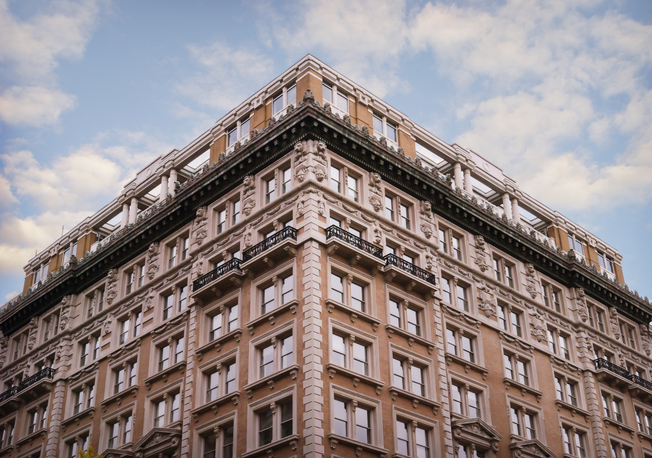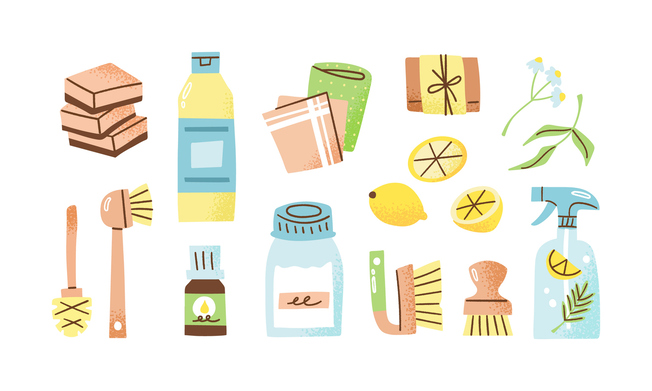
The Art of Bonsai for Apartment Dwellers

By Rachel Craft
Nov 22, 2023
Bonsai are more than just your typical houseplants — they’re a living piece of art, and a great way to bring a piece of the forest into your home. While bonsai are trickier to grow and maintain than many houseplants, with a few tips, even apartment dwellers can get in on this ancient art form. We spoke with two bonsai artists who share their tips for making bonsai gardens in their apartments.
What is a Bonsai Tree?
While many associate the art of bonsai with Japan, the East Asian art form actually originated in China — where it was called penjing. One of the main differences between the Japanese bonsai and the Chinese penjing is that the former is focused on small trees, while the latter displays also include various other elements like rocks, water, or statuettes.
Although they resemble “dwarf” trees, bonsai are not bred or genetically engineered to be smaller. They have the potential to grow as large as their forest-dwelling cousins, but because they are pruned and kept in a shallow pot, they end up looking like miniature trees. Depending on the species, bonsai may change color in the fall, grow flowers in the spring, or even produce fruit.
Outdoor vs. Indoor Bonsai
Many of the bonsai you’ll see for sale in grocery and home improvement stores are tropical species, which are well suited to life indoors in a small space. These trees thrive in consistently warm temperatures. Tropical bonsai species include Ficus, schefflera, Fukien tea tree, and Brazilian rain tree. There’s also snow rose and natal plum, which produce flowers, as well as jade, which is technically a succulent.
Coniferous and deciduous bonsai, on the other hand, are used to colder climates — and they need low temperatures to survive. Maat James, a professional bonsai artist from Portland, OR, spent the first 15 years of his career growing these types of bonsai in his apartment. Coniferous and deciduous bonsai “have adapted to the cold by taking a nap during winter so they can replenish their strength and build their reserves for the following spring,” James says. “That dormancy period is crucial.”
As a result, deciduous and coniferous bonsai need to stay outside most of the year. But you can bring them indoors occasionally — say, to decorate your house with their colorful fall foliage or enjoy their spring flowers.
If your apartment has no outdoor space, you’ll have more success trying your hand at tropical bonsai. If you have a sunny balcony or porch, that opens a whole new world of deciduous and coniferous options.
How Do You Take Care of a Bonsai?
If you’re interested in trying the art of bonsai, you don’t need to make a big investment. Some types of bonsai can be grown from a cutting, or a twig cut from a larger tree. Cuttings are usually young and green, only a few inches long and around 1/8” thick, with the lower third of the leaves (closest to the tree) removed. When you place the bottom part of the cutting into a pot of soil and keep it lit and watered, it will start growing roots of its own in three to five weeks.
This approach takes effort and patience, but it’s free — so if you kill your first bonsai or two, you haven’t lost much of an investment. It’s also a great way to learn about bonsai care firsthand. If you want to try it, James recommends cotoneaster, willow, and red twig dogwood as some of the easiest trees for cuttings.
A slightly easier approach for newbies that’s still relatively cheap is to go to your local nursery and buy a few pieces of generic landscape stock — baby trees in four-inch or one-gallon pots. These are a little further along in the growth process than cuttings, but they’re still easy to train as they grow into full bonsai.
You can also buy larger, more established bonsai at nurseries and home improvement stores, but James doesn’t recommend this for bonsai beginners: “That would be an expensive casualty if it were to die. It’s best to start small and get good at it first before investing more time and money.”
Find the Right Lighting
“The biggest challenge of growing any plant indoors, especially bonsai, is getting adequate light,” James says.
If your apartment doesn’t have an outdoor space, your tropical bonsai will appreciate a bright, sunny window. If your window doesn’t get enough direct sunlight to keep your bonsai happy, you can supplement with a grow light. Grow lights are affordable and easy to find at most hardware stores. You can use a regular lamp and simply replace the bulb with one that’s designed to mimic the light spectrum of the sun.
Deciduous and coniferous bonsai are easy to grow on an apartment balcony, as long as they get plenty of sunlight. South-facing (if you live in the Northern Hemisphere) balconies are ideal, but east- and west-facing are usually sufficient. Sun-loving species include beech, hornbeam, crabapple, olive, boxwood, and juniper bonsai. Japanese maples are known for their deep red autumn foliage, while dogwood trees produce beautiful pink or white flowers in the spring.
If your balcony is north-facing, don’t worry — just choose a bonsai species that’s more suited to shade, like hemlock, redwood, ninebark, quince, yew, or azalea. Chris Rigoni, a Perth, Australia–based tattoo artist and bonsai hobbyist, has spent the last six years caring for bonsai in high-rise apartments. “Apartments [are] more suited for tree varieties that require less sun,” he says.
Practice Leaf Hygiene
Another challenge when keeping bonsai indoors is that their leaves will collect dust over time, and dust can attract bugs. James recommends putting your bonsai outside in the rain occasionally, or washing the leaves gently in your shower or sink. “A clean plant is less likely to suffer from bugs,” James says.
Control the Temperature
Like most plants, bonsai can be affected by extreme temperature swings. Tropical bonsai are susceptible to cold snaps, so if you keep them outside during the warmer months, you’ll need to bring them indoors for the winter.
Deciduous and coniferous bonsai are adapted to life outdoors in cold climates, but they’re more susceptible to hard freezes (temperatures below 28°F) than their larger counterparts. That’s because bigger trees’ roots are insulated by the soil, while bonsai live in small pots that are exposed to the elements on all sides. When the weather dips below freezing, you’ll need to protect your bonsai’s delicate roots.
You can wrap the pot in towels or blankets, move the bonsai to an outdoor closet that’s sheltered from the elements, or bring it indoors temporarily. “The tops are fine,” James says. “The goal is to protect the roots from freezing.”
Sweltering summer days pose a similar threat. Temps that soar into the triple digits can be stressful and damaging to bonsai. If a heatwave is coming, bring your bonsai indoors until the weather cools off, and keep it in a window or under a grow light to ensure it gets enough sun.
If you live in a warm region where most of the summer will be too hot for your bonsai, look for white or light-colored shade cloth at your local nursery or hardware store. Shade cloth is a thin, lightweight netting that reflects some of the sun’s heat while letting most light through, helping keep your bonsai cool and comfortable.
Stay Hydrated
Because bonsai like shallow pots and plenty of sun, their soil dries out quickly — especially if you live in a dry climate or a high-rise apartment. Rigoni has experienced both challenges. “In Perth, the summer wind is very hot and dry,” he says. “And it’s a lot drier environment on a balcony 17 floors up, compared to a [ground-floor] garden.”
The drier your bonsai’s environment, the more vigilant you’ll need to be about watering it regularly. James says, “A nice big watering can with a sprinkler head is best so you can soak the whole tree, leaves, and roots.”
Stay Positive
One last tip: Don’t get disheartened if your first few attempts at bonsai don’t work out. James says most bonsai experts have lost dozens of trees while they were first learning the ropes. As with any other art form, he says, “trial and error are part of the process.”
All photos courtesy of Maat James.
Top cities
Atlanta Apartments
1,870 apartments starting at $630/month
Austin Apartments
5,932 apartments starting at $600/month
Baltimore Apartments
1,482 apartments starting at $640/month
Boston Apartments
5,705 apartments starting at $425/month
Charlotte Apartments
3,066 apartments starting at $570/month
Chicago Apartments
5,366 apartments starting at $400/month
Dallas Apartments
5,476 apartments starting at $625/month
Fort Worth Apartments
2,679 apartments starting at $695/month
Houston Apartments
5,693 apartments starting at $450/month
Las Vegas Apartments
1,007 apartments starting at $750/month
Los Angeles Apartments
12,690 apartments starting at $750/month
Miami Apartments
758 apartments starting at $1,200/month
Milwaukee Apartments
1,139 apartments starting at $475/month
New York Apartments
9,009 apartments starting at $600/month
Oakland Apartments
939 apartments starting at $850/month
Orlando Apartments
834 apartments starting at $895/month
Philadelphia Apartments
3,580 apartments starting at $500/month
Phoenix Apartments
3,533 apartments starting at $660/month
Pittsburgh Apartments
1,375 apartments starting at $550/month
Portland Apartments
2,269 apartments starting at $575/month
Raleigh Apartments
1,491 apartments starting at $550/month
San Antonio Apartments
3,382 apartments starting at $525/month
San Diego Apartments
2,812 apartments starting at $650/month
San Francisco Apartments
660 apartments starting at $500/month
San Jose Apartments
503 apartments starting at $1,100/month
Seattle Apartments
3,446 apartments starting at $452/month
Tampa Apartments
787 apartments starting at $850/month
Washington DC Apartments
2,273 apartments starting at $910/month


